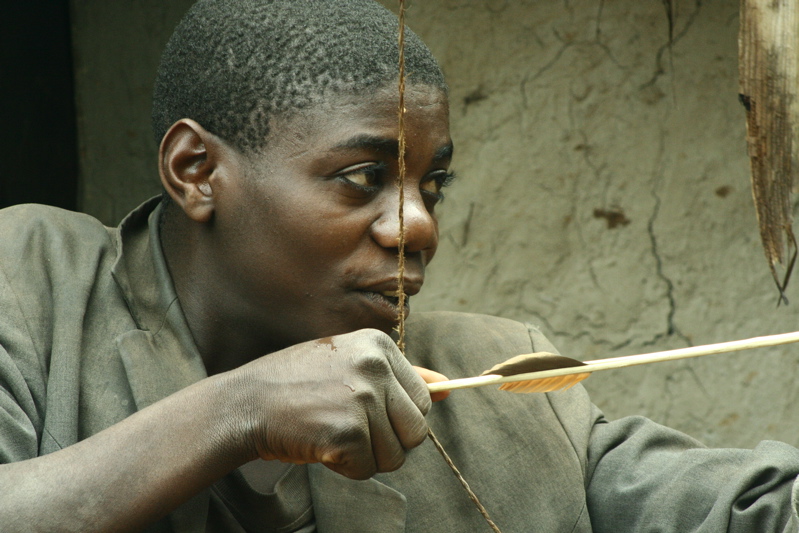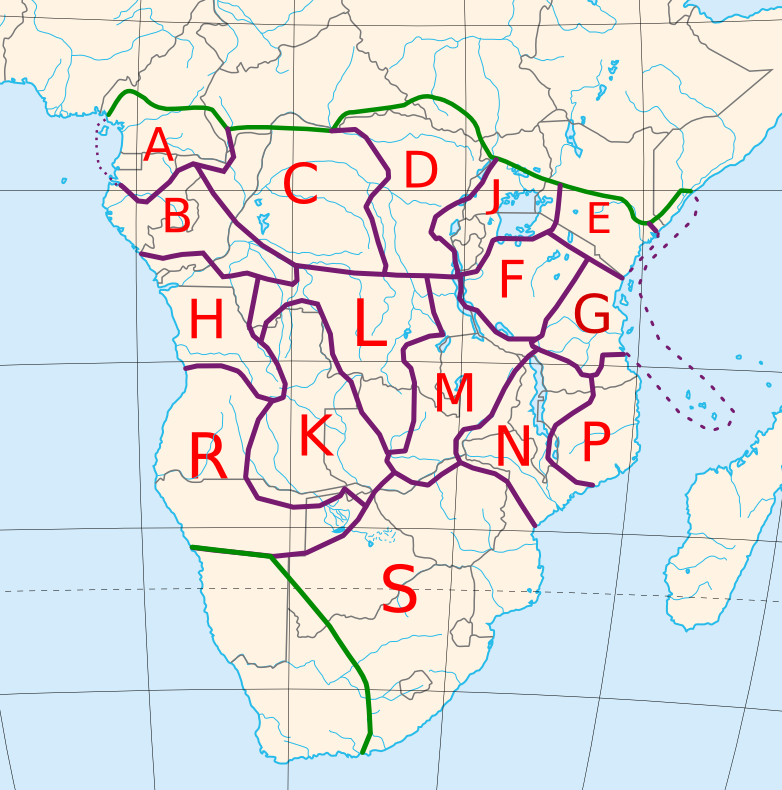|
Hutu
The Hutu (), also known as the Abahutu, are a Bantu ethnic group native to the African Great Lakes region. They mainly live in Rwanda, Burundi, and Uganda where they form one of the principal ethnic groups alongside the Tutsi and the Great Lakes Twa. Demographics The Hutu is the largest of the three main population divisions in Burundi and Rwanda. Prior to 2017, the CIA World Factbook stated that 84% of Rwandans and 85% of Burundians are Hutu, with Tutsis being the second largest ethnic group at 15% and 14% of residents of Rwanda and Burundi, respectively. However, these figures were omitted in 2017 and no new figures have been published since then. The Twa pygmies, the smallest of the two countries' principal populations, share language and culture with the Hutu and Tutsi. They are distinguished by a considerably shorter stature. Etymology The idea that Hutu is etymologically derived from a word that signifies slave was advanced by Ernest Viaene (1910, p.1047) ... [...More Info...] [...Related Items...] OR: [Wikipedia] [Google] [Baidu] |
Rwandan Genocide
The Rwandan genocide, also known as the genocide against the Tutsi, occurred from 7 April to 19 July 1994 during the Rwandan Civil War. Over a span of around 100 days, members of the Tutsi ethnic group, as well as some moderate Hutu and Great Lakes Twa, Twa, were systematically killed by Hutu militias. While the Constitution of Rwanda, Rwandan Constitution states that over 1 million people were killed, most scholarly estimates suggest between 500,000 and 662,000 Tutsi died, mostly men. The genocide was marked by extreme violence, with victims often murdered by neighbors, and widespread sexual violence, with between 250,000 and 500,000 women raped. The genocide was rooted in long-standing ethnic tensions, exacerbated by the Rwandan Civil War, which began in 1990 when the Rwandan Patriotic Front (RPF), a predominantly Tutsi rebel group, invaded Rwanda from Uganda. The war reached a tentative peace with the Arusha Accords (Rwanda), Arusha Accords in 1993. However, the Assassina ... [...More Info...] [...Related Items...] OR: [Wikipedia] [Google] [Baidu] |
Burundi
Burundi, officially the Republic of Burundi, is a landlocked country in East Africa. It is located in the Great Rift Valley at the junction between the African Great Lakes region and Southeast Africa, with a population of over 14 million people. It is bordered by Rwanda to the north, Tanzania to the east and southeast, and the Democratic Republic of the Congo to the west; Lake Tanganyika lies along its southwestern border. The political capital city is Gitega and the economic capital city is Bujumbura. The Great Lakes Twa, Twa, Hutu and Tutsi peoples have lived in Burundi for at least 500 years. For more than 200 of those years, Burundi was an independent Kingdom of Burundi, kingdom. In 1885, it became part of the German colony of German East Africa. After the First World War and German Revolution of 1918–19, Germany's defeat, the League of Nations mandated the territories of Burundi and neighboring Rwanda to Belgium in a combined territory called Rwanda-Urundi. After the Se ... [...More Info...] [...Related Items...] OR: [Wikipedia] [Google] [Baidu] |
Rwanda
Rwanda, officially the Republic of Rwanda, is a landlocked country in the Great Rift Valley of East Africa, where the African Great Lakes region and Southeast Africa converge. Located a few degrees south of the Equator, Rwanda is bordered by Uganda, Tanzania, Burundi, and the Democratic Republic of the Congo. With a comparatively high elevation, Rwanda has been given the sobriquet "land of a thousand hills" (), with its geography dominated by mountains in the west and savanna to the southeast, with numerous lakes throughout the country. The climate is temperate to subtropical, with two rainy seasons and two dry seasons each year. It is the most densely populated mainland African country; among countries larger than 10,000 km2, it is the third-most densely populated country in the world. Its Capital city, capital and largest city is Kigali. Hunter-gatherers settled the territory in the Stone Age, Stone and Iron Ages, followed later by Bantu peoples. The population coalesce ... [...More Info...] [...Related Items...] OR: [Wikipedia] [Google] [Baidu] |
Tutsi
The Tutsi ( ), also called Watusi, Watutsi or Abatutsi (), are an ethnic group of the African Great Lakes region. They are a Bantu languages, Bantu-speaking ethnic group and the second largest of three main ethnic groups in Rwanda and Burundi (the other two being the largest Bantu peoples, Bantu ethnic group Hutu and the African Pygmies, Pygmy group of the Twa). Historically, the Tutsi were Pastoralism, pastoralists and filled the ranks of the warriors' caste. Before 1962, they regulated and controlled Rwandan society, which was composed of Tutsi aristocracy and Hutu commoners, utilizing a clientship structure. They occupied the dominant positions in the sharply stratified society and constituted the ruling class. Origins and classification The historian Christopher Ehret believes that the Tutsi mainly descend from speakers of an extinct branch of South Cushitic languages, South Cushitic he calls "Tale south Cushitic." The Tale southern cushites entered the Great Lakes region s ... [...More Info...] [...Related Items...] OR: [Wikipedia] [Google] [Baidu] |
Tutsi People
The Tutsi ( ), also called Watusi, Watutsi or Abatutsi (), are an ethnic group of the African Great Lakes region. They are a Bantu-speaking ethnic group and the second largest of three main ethnic groups in Rwanda and Burundi (the other two being the largest Bantu ethnic group Hutu and the Pygmy group of the Twa). Historically, the Tutsi were pastoralists and filled the ranks of the warriors' caste. Before 1962, they regulated and controlled Rwandan society, which was composed of Tutsi aristocracy and Hutu commoners, utilizing a clientship structure. They occupied the dominant positions in the sharply stratified society and constituted the ruling class. Origins and classification The historian Christopher Ehret believes that the Tutsi mainly descend from speakers of an extinct branch of South Cushitic he calls "Tale south Cushitic." The Tale southern cushites entered the Great Lakes region sometime before 800BC and were pastoralists par excellence, relying only on their liv ... [...More Info...] [...Related Items...] OR: [Wikipedia] [Google] [Baidu] |
Great Lakes Twa
The Great Lakes Twa, also known as Batwa (singular Mutwa), Abatwa or Ge-Sera, are a Bantu speaking group native to the African Great Lakes region on the border of Central and East Africa. As an indigenous pygmy people, the Twa are generally assumed to be the oldest surviving population of the Great Lakes region. Current populations of Great Lakes Twa people live in the states of Rwanda, Burundi, Uganda and the eastern portion of the Democratic Republic of Congo. In 2000 they numbered approximately 80,000 people, making them a significant minority group in these countries. The largest population of Twa is located in Burundi estimated in 2008 at 78,071 people. Apart from anthropological literature, the term "Twa" generally refers to the Twa of the Great Lakes region. There are a number of other Twa populations in the Congo forest, as well as southern Twa populations living in swamps and deserts where there has never been forest, but these are little known in the West. History ... [...More Info...] [...Related Items...] OR: [Wikipedia] [Google] [Baidu] |
Bantu Peoples
The Bantu peoples are an Indigenous peoples of Africa, indigenous ethnolinguistic grouping of approximately 400 distinct native Demographics of Africa, African List of ethnic groups of Africa, ethnic groups who speak Bantu languages. The languages are native to countries spread over a vast area from West Africa, to Central Africa, Southeast Africa and into Southern Africa. Bantu people also inhabit southern areas of Northeast African states. There are several hundred Bantu languages. Depending on the definition of Dialect#Dialect or language, "language" or "dialect", it is estimated that there are between 440 and 680 distinct languages. The total number of speakers is in the hundreds of millions, ranging at roughly 350 million in the mid-2010s (roughly 30% of the demographics of Africa, population of Africa, or roughly 5% of world population, the total world population). About 90 million speakers (2015), divided into some 400 ethnic or tribal groups, are found in the Democratic Re ... [...More Info...] [...Related Items...] OR: [Wikipedia] [Google] [Baidu] |
Kirundi
Kirundi (), also known as Rundi, is a Bantu language and the national language of Burundi. It is mutually intelligible with Kinyarwanda, the national language of Rwanda, and the two form parts of the Rwanda-Rundi dialect continuum spoken in Burundi, Rwanda, Tanzania, Uganda, and Kenya. Kirundi is natively spoken by the Hutu (including the Bakiga), Tutsi, Twa, and the Hima people; other related ethnicities have also adopted Kirundi as their mother tongue. Neighbouring dialects of Kirundi are mutually intelligible with Ha language, Ha, a language spoken in western Tanzania. Kirundi is one of the languages where Meeussen's rule, a rule describing a certain pattern of tonal change in Bantu languages, is active. In 2020, the Rundi Academy was established to help standardize and promote Kirundi. Phonology Consonants Although the literature on Rundi agrees on 5 vowels, the number of consonants can vary anywhere from 19 to 26 consonants. The table below is compiled from a survey ... [...More Info...] [...Related Items...] OR: [Wikipedia] [Google] [Baidu] |
Rwanda-Rundi
Rwanda-Rundi or West Highlands Kivu is a group of Bantu languages, specifically a dialect continuum, spoken in Central Africa. Two dialects, Kirundi and Kinyarwanda, have been standardized as the national languages of Burundi and Rwanda respectively. These neighbouring dialects are mutually intelligible, but other dialects which are more distant ones may not be. The other dialects are spoken in the Democratic Republic of the Congo (Kinyabwisha in North Kivu), Uganda (Rufumbira, spoken by the Bafumbira in Kisoro District), and Tanzania; Ha, with one million speakers, is the most widely spoken. Comparison of Kinyarwanda and Kirundi Kinyarwanda and Kirundi are very similar in many aspects, but differ in several ways as well. Tonal marking Both languages are tonal languages. High and low tones (or H and L) are the essential tones and, having a phonemic distinction on vowel length, when a long vowel changes from a low tone to a high tone it is marked as a rising tone and when a ... [...More Info...] [...Related Items...] OR: [Wikipedia] [Google] [Baidu] |
American Journal Of Human Genetics
The ''American Journal of Human Genetics'' is a monthly peer-reviewed scientific journal in the field of human genetics. It was established in 1948 by the American Society of Human Genetics and covers all aspects of heredity in humans, including the application of genetics in medicine and public policy, as well as the related areas of molecular and cell biology. According to the ''Journal Citation Reports'', the journal has a 2019 impact factor of 10.502. The journal is published by Cell Press an imprint of Elsevier Elsevier ( ) is a Dutch academic publishing company specializing in scientific, technical, and medical content. Its products include journals such as ''The Lancet'', ''Cell (journal), Cell'', the ScienceDirect collection of electronic journals, .... Bruce R. Korf became the editor-in-chief in the winter of 2017–2018. Past editors-in-chief * 1948–1951 — Charles W. Cotterham * 1952–1954 — Herluf H. Strandskov (1898–1984) * 1955— Laurence H. Snyde ... [...More Info...] [...Related Items...] OR: [Wikipedia] [Google] [Baidu] |
Bantu Languages
The Bantu languages (English: , Proto-Bantu language, Proto-Bantu: *bantʊ̀), or Ntu languages are a language family of about 600 languages of Central Africa, Central, Southern Africa, Southern, East Africa, Eastern and Southeast Africa, Southeast Africa. They form the largest branch of the Southern Bantoid languages. The total number of Bantu languages is estimated at between 440 and 680 distinct languages, depending on the definition of Dialect#Dialect or language, "language" versus "dialect"."Guthrie (1967–71) names some 440 Bantu 'varieties', Grimes (2000) has 501 (minus a few 'extinct' or 'almost extinct'), Bastin ''et al.'' (1999) have 542, Maho (this volume) has some 660, and Mann ''et al.'' (1987) have ''c.'' 680." Derek Nurse, 2006, "Bantu Languages", in the ''Encyclopedia of Language and Linguistics'', p. 2:Ethnologue report for Southern Bantoid" lists a total of 535 languages. The count includes 13 Mbam languages, which are not always included under "Narrow Bantu". ... [...More Info...] [...Related Items...] OR: [Wikipedia] [Google] [Baidu] |
University Of Dayton
The University of Dayton (UD) is a Private university, private, Catholic research university in Dayton, Ohio, United States. Founded in 1850 by the Society of Mary (Marianists), Society of Mary, it is one of three Marianist universities in the US and the second-largest private university in Ohio. Its campus is located in southern Dayton and spans 388 acres on both sides of the Great Miami River. The campus is noted for the Immaculate Conception Chapel and the University of Dayton Arena. As of 2023, the university enrolls approximately 11,300 undergraduate and postgraduate students from a variety of religious, ethnic and geographic backgrounds. It offers more than 80 academic programs in the arts, sciences, business, education, health sciences, engineering, and law. In 2009, UD offered what it believes to be one of the first undergraduate degree programs in human rights. It is Carnegie Classification of Institutions of Higher Education, classified among "R1: Doctoral Universities ... [...More Info...] [...Related Items...] OR: [Wikipedia] [Google] [Baidu] |






